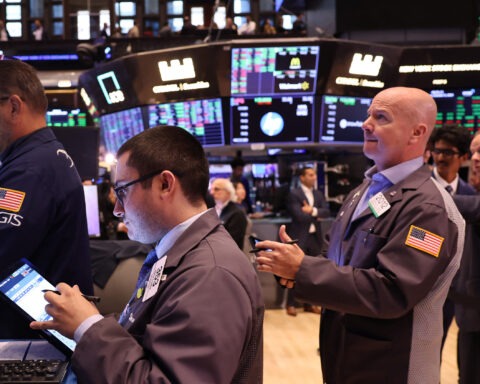On March 14, 2025, gold prices surged past $3,000 per ounce for the first time in history, driven by a wave of investor panic sparked by escalating U.S. trade tensions, economic uncertainty, and geopolitical instability.
The precious metal, long a safe-haven asset, climbed to an all-time high of $3,004.86 before settling at $2,986.26 by day’s end, as detailed by Reuters, reflecting fears over President Donald Trump’s tariff war and a faltering stock market.
While CNN and NBC tied the rally to Wall Street’s rejection of Trump’s erratic economic agenda, Fox News highlighted central bank buying and a weakening dollar as key drivers, and BBC underscored broader global unease, including Russia’s rejection of a Ukraine ceasefire. This article explores the catalysts behind gold’s historic climb, its economic and psychological underpinnings, the contrasting media narratives, and the uncertain road ahead as investors brace for turbulence.
The Milestone Moment: Gold Breaks $3,000
The breach of the $3,000 barrier on March 14 was a watershed for gold markets. CNN reported that spot gold hit $3,004.86 mid-session, a record that capped a 13.6% rise in 2025 alone, per Forbes. By 2:01 p.m., it eased slightly to $2,986.26, yet held its highest weekly close ever, as BBC noted. This surge built on a 27% rally over the past year, fueled by a cocktail of fear and flight to safety. Fox News described it as a “historic safe-haven rally,” with investors piling into gold to shield against Trump’s trade war, which saw 25% tariffs on steel and aluminum imports kick in on March 12, per Saudi Gazette.
NBC News tied the day’s volatility to a broader market context: U.S. stocks rallied 675 Dow points on Friday—the best day since November 2024—yet couldn’t erase a week of losses, with the Dow down 3.1% since March 10, its worst since 2023. Gold’s ascent stood in stark contrast, a beacon for jittery investors as the S&P 500 lingered near correction territory, down over 10% from its February peak, per The Washington Post.
Trump’s Tariff Tantrum: The Economic Trigger
President Trump’s trade policies were the rally’s linchpin. CNN’s March 14 piece, “Wall Street is turning its back on Trump,” detailed how his on-again, off-again tariffs—first targeting Canada and Mexico, then hiking China’s to 20%—spooked markets. The Washington Post reported a $5.28 trillion wipeout in S&P 500 value since February 19, with Reuters pegging losses at $4 trillion. Trump’s refusal to rule out a recession, aired on Fox News over the weekend, deepened the gloom, pushing investors toward gold.
BBC linked the tariff chaos to global repercussions: Canada and the EU swiftly retaliated with countermeasures, per Saudi Gazette, amplifying trade war fears. Jason Hollands of Evelyn Partners told CNN that gold had become “the panic asset of choice” amid this “extreme uncertainty facing the global trade system.” Fox News added that a weakening U.S. dollar—hitting an 11-month low, per BBC—made gold more attractive to foreign buyers, supercharging demand.
Geopolitical Jitters: Ukraine and Beyond
Geopolitical instability provided a potent backdrop. BBC reported Russia’s mid-week rejection of a U.S.-proposed 30-day ceasefire in Ukraine, a move Sucden Financial’s Viktoria Kuszak called a “reignition of instability.” NBC tied this to Trump’s March 3 comments about “getting along” with Russia, which clashed with NATO allies’ hardline stance, per The Guardian. The uncertainty—compounded by Putin’s Kursk gains, per Reuters—sent investors scrambling for gold’s stability.
CNN noted additional global tailwinds: central banks, led by China, stockpiled gold to hedge against reserve seizures, a lesson from Russia’s 2022 sanctions, per Saudi Gazette. This demand, alongside $9.4 billion in February ETF inflows—the largest since March 2022, per Forbes—propelled gold’s rally. NBC’s coverage of Poland’s nuclear pleas to the U.S., per the Financial Times, underscored a world on edge, further burnishing gold’s safe-haven allure.
Economic Angst: Consumer Sentiment Plummets
Domestic economic signals amplified the panic. CNN’s Fear and Greed Index sank to 16—“extreme fear”—on March 10, its lowest in over a year. NBC reported a University of Michigan survey showing consumer sentiment cratering to 57.9 in March, down 11% from February’s 64.7—the weakest since November 2022. The New York Times tied this to tariff fears and slowing growth, with consumers and businesses bracing for higher prices.
Gold’s rise mirrored this unease. Fox News highlighted its 15% year-to-date gain, outpacing the S&P 500’s 4% loss, as investors fled equities. “It’s a sign of uncertainty when faith in leadership wanes,” Lawrence Summers told CNN, pointing to gold’s psychological role. BBC added that a global monetary easing cycle—rate cuts in 2024, per Forbes—bolstered gold’s appeal over bonds, whose yields tumbled, per CNN.
Media Perspectives: A Tale of Divergent Narratives
Media outlets framed gold’s surge through distinct lenses. Fox News celebrated it as a rational response to central bank buying and dollar weakness, with analysts like Jeffrey Gundlach of DoubleLine predicting $4,000 by year-end, per Forbes. CNN cast it as Wall Street’s rebuke of Trump’s “chaotic economic agenda,” quoting B. Riley’s Art Hogan: “The market is sick and tired of the back-and-forth on trade policy.” NBC bridged the gap, noting both geopolitical and economic drivers, while warning of stagflation risks if tariffs bite.
BBC took a global view, tying gold’s rally to trade wars, Ukraine, and central bank hoarding, with a nod to its record weekly close. Reuters and Saudi Gazette emphasized investor panic, with the latter quoting Hollands’ “panic asset” label.
The Psychology of Panic: Why Gold Now?
Gold’s surge is as much emotional as economic. CBS News’ March 14 piece, “Gold’s price breaks record $3,000,” called it a “moment long anticipated,” tapping into its role as a portfolio protector. CNN’s coverage of safe-haven flows—echoed by Reuters—highlighted investors’ flight from stocks, with the Nasdaq down 10% year-to-date, per Yahoo Finance. “When uncertainty reigns, gold shines,” Hollands told Saudi Gazette, a sentiment NBC’s analysts echoed as Tesla and Nvidia bled value.
The panic button, pressed amid Trump’s unpredictability, reflects a deeper unease. The Washington Post noted gold’s 37.8% one-year gain via ETFs like GLD, per Forbes, as institutional and retail investors alike sought refuge. BBC’s report of central banks diversifying from dollar reserves underscored a systemic shift, amplifying gold’s psychological pull in a world of faltering trust.
The Road Ahead: Sustained Rally or Reversal?
Analysts diverge on gold’s trajectory. Goldman Sachs, per Reuters, sees upside to $3,100-$3,300 by year-end, citing policy uncertainty. Gundlach’s $4,000 call, per Forbes, bets on momentum traders chasing the rally. Yet, CNN’s Yung-Yu Ma predicted a “multi-day relief rally” in stocks that could temper gold’s ascent if Trump’s economic outlook improves, a hope Fox News pinned on a shutdown aversion.
Risks loom. CBS News cautioned that safe-haven flows might wane if growth stabilizes, while Reuters warned of a reversal if tariffs ease. BBC’s forecast of a potential S&P 500 drop to 5,300—another 5.5% fall—could sustain gold’s climb, but NBC’s upcoming retail sales report on March 17 looms as a litmus test. A weak 0.6% February rise, per Dow Jones estimates, could reignite panic, bolstering gold further.
Conclusion: Gold’s Golden Moment
Gold’s leap to $3,000 on March 14, 2025, marks a defining chapter in a volatile year, as investors—spooked by Trump’s tariffs, geopolitical strife, and economic gloom—pushed the panic button. BBC, CNN, NBC, and Fox News captured a multifaceted surge: a safe-haven rush amid stock market chaos, a hedge against a weakening dollar, and a shield for a world in flux. Whether this rally endures or fades hinges on Trump’s next moves, global stability, and economic data. For now, gold stands as a glittering testament to uncertainty’s grip—and a reminder that in times of crisis, the oldest currency still reigns supreme.















